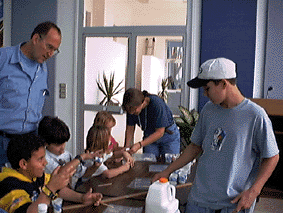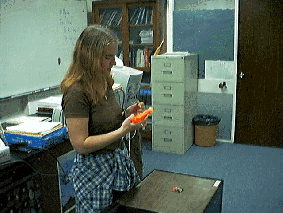| Sharing Science | |||||||||||
| Kids Teaching Kids | |||||||||||
| Be An Einstein...Ask Why? | |||||||||||
| On-Line Physics | |||||||||||
| Enrichments | |||||||||||
| Collaboratives | |||||||||||
If you would like any information on these or other collaborative programs please use the following e-mail address: send mail to kskrutvold@uswest.net.






Universally science teachers continue to lament that most high school students enroll in just the minimum number of science classes. I have found that a large-scale Physics science roadshow for elementary students and the high school students is one wonderful way to spread the word and excitement of science, involve teachers, and eventually increase the number of students taking more science classes in their futures. I am convinced, based on my experiences, that such science demonstration shows can be organized and produced by anyone.
The "Kids Teaching Kids" program is a learning experience for all students and can also serve as a superb in-service event for teachers. I hope that this outline and the time-saving tips will help each of you to build an extravaganza...or at least a small circus of science thrills for the elementary students.
Why Do We Do It?
To increase the science awareness and interest in the schools elementary grades. To develop stronger links with elementary teachers. To make these future science students feel they knew the high school physics students and shared a common experience. To increase the percentage of students who become involved in activities that can be done at home or in the elementary classroom. To expose both diverse age groups to science topics and activities that are fun and enjoyable.
Steps to Follow for a Successful Show:
1. Wow them!!
From our classroom experiences we all know that kids love to be "wowed." Although it is hard to predict, try to ensure that most of the science demonstrations are dramatic. Test them on your peers and for me!
2. Big Scale
Inviting the elementary teachers to participate in the program is usually accomplished by word of mouth and the success of last years program, so remind yourself (as any drama director would) that everything presented on stage must be easily seen by the audience. Have large displays or apparatus with bright colors that can indicate and introduce each science category that your are demonstrating from; e.g., Temperature, Energy, Momentum.
3 Planning, Logistics, and Public Relations
a) For any show you need an enthusiastic audience. I will contact the elementary teachers with a personalized invitation to partake in the program. I will make sure that we allow some lead time, so the opportunity of the teachers to incorporate your presentation into some possible lessons, and second, we will need to set up a schedule so we can deal with prior commitments. This allows for us to adapt our schedule so the elementary classrooms aren't constantly rescheduling for us!
b) After contacting the elementary teachers, I will try to furnish them with public-relations flyers and memo reminders of dates and times of the roadshows. Give your show a name; e.g., "Balloons, Bowling Balls, and Monkeys", set a time, and I will send a formal letter to each elementary teacher that wishes to participate in the program with all the necessary information.
c) After distributing informational flyers, I will follow up with phone calls.
d) During your presentation, I will be going from classroom to classroom taking pictures and video taping the performances. This will then be available for viewing after the "Kids Teaching Kids" program has come to its conclusion.
4. Targeting and Evaluating Students' Learning
The size and scheduling of the groups attending your show will partially dictate the teaching goals you set and are able to evaluate during and after a show. Our shows will be constrained by the logistics of the schools, which will require a loosely timed show and schedule. Your show's format should involve a set of science topics each of which was introduced with a question posed to the entire audience. A sign unveiled by you can announce each topic. There should be some time given during the roadshow for give-and-take questioning, even with a timed show. However, when presenting to a large group of students from a variety of backgrounds, the elementary classroom teacher can also help in facilitating the back-and-forth questioning that can help the smooth running of the show. You must also provide attending teachers with explanations of the show's science topics and follow-up activities. You will find that the elementary students and teachers are very appreciative and many thank-you notes will be received. Encourage the attending classes to your show, at the end of the show, to submit their follow-up questions if there is a time crunch to answer them on the spot. Writing back can allow you to explain in detail, provide additional activities, furnish references, and further strengthen the connections with the elementary students and teachers.
5. What to Present?
We will first have to select some of the topics, based on what is currently being covered in the elementary classrooms. I will then set out some resource materials to find appropriate demonstrations that you will be able to choose from in the Physics lab. As a guiding philosophy, choose demos that you enjoy, which can be explained quickly, and are large and visible. Make sure that your roadshow groups spends some time planning the presentation strategy. Attempt to make the show up-close and personal with the elementary students, encourage elementary student participation.
Although the sky's the limit, here is a short listing of some physics possibilities or choices.
- Low and High Air Pressure
- Conservation of Energy
- Centripetal Force
- Momentum and Collisions
- Laser Light Phenomenon
- Angular Motion and its Properties
We will utilize our class periods for the demonstration roadshows, set-up, run the show, and take it down. For a 40 -to- 50 minutes show depending on the demos you decide to use, plan on four hours to set up and two hours to pack up materials for the traveling roadshows. This means that we will need about 6-7 hours for deciding on what demos you will do and then putting together the materials for the demos to travel with. Since you will be doing multiple presentations, they will be scheduled per calendar and convenience to the elementary classroom teachers.
7. The Big Day
a) Although there will be a lot of excitement, make sure that there is something to catch the students' attention before you begin your show. One way to do this is to display a poster of the topics to bring the attention of the students to some point of focus.
b) Make sure the student seating and your position for the roadshow is appropriate for maximum viewing for all students.
c) Before the show hand the classroom teacher a copy of the physics resource manual that has been produced and an evaluation sheet. Have the teachers rate the demos and supply comments on the presentations. Thank them for allowing us to share science in their classrooms!!
d) The resource manual referenced in part c is a typed 1 page per demo, with diagrams or pictures of apparatus, list of materials needed, purpose or objective of the demo, what physics concepts can be taught or introduced with the demo, and any descriptions and explanations of fun demos or extensions that teachers might want to do in their classrooms on a later date, and also some questions (follow-up) that can be used by the teachers if they attempt these next year. The manual should be a desk reference for the teachers.
e) As mentioned earlier, I will be taking pictures and trying to videotape as much as I can so that we can analyze after the performances to help remember what worked and really involved the audience in the sharing of science shows.
f) The show begins!!! Tell the students and teachers what they will see and introduce yourself.
g) Make presentations with gusto, humor, questioning, and signs!
h) Field questions as they arise, and try to promote involvement by initiating the questioning process. Then again at the end of the show ask if there are any questions, answer appropriately, then thank them profusely for allowing you to share science with them.
i) Pack up the show materials in your traveling containers or organized boxes. Now, we can load the van/bus/trolley/carts and head back to the High School.
On the Side!
Your shows will be successful from both an entertainment and educational perspective if you have fun and are enthusiastic! Keep the attention level high by involving the audience when you can. Let the show begin!!